Effect of Degree of Ethoxylation on the Surface and Thermal Properties of Polymeric Ionic Liquids for Oilfield Applications
Abstract
1. Introduction
2. Materials and Methods
2.1. Materials
2.2. Synthesis Process of PILs
2.3. Chemical Structure Elucidation
2.4. Thermal Gravimetric Analysis
2.5. Salt Tolerance Test
2.6. Surface Tension Measurement
3. Results and Discussion
3.1. NMR of PILs
3.2. FTIR of PILs
3.3. TGA Analysis
3.4. Salt Tolerance of PILs
3.5. Surface Tension Analysis
3.6. Thermodynamics Properties
4. Conclusions
Author Contributions
Funding
Institutional Review Board Statement
Data Availability Statement
Conflicts of Interest
References
- Tamayo-Mas, E.; Mustapha, H.; Dimitrakopoulos, R. Testing Geological Heterogeneity Representations for Enhanced Oil Recovery Techniques. J. Pet. Sci. Eng. 2016, 146, 222–240. [Google Scholar] [CrossRef]
- Li, X.; Zhang, J.; Zhang, Y.; Guan, C.; Liu, Z.; Hu, K.; Xian, R.; Li, Y. Experimental Study on the Application of Polymer Agents in Offshore Oil Fields: Optimization Design for Enhanced Oil Recovery. Polymers 2025, 17, 244. [Google Scholar] [CrossRef] [PubMed]
- Saxena, N.; Goswami, A.; Dhodapkar, P.; Nihalani, M.; Mandal, A. Bio-based surfactant for enhanced oil recovery: Interfacial properties, emulsification and rock-fluid interactions. J. Pet. Sci. Eng. 2019, 176, 299–311. [Google Scholar] [CrossRef]
- Nazar, M.; Hussain, S.M.S.; Kamal, M.S. Deep Eutectic Solvents: Comprehensive Review and Future Directions on Synthesis and Oilfield Applications. Energy Fuels 2024, 38, 10653–10672. [Google Scholar] [CrossRef]
- Somoza, A.; García-Mayoral, M.F.; Soto, A. A Formulation Based on a Cationic Surface-Active Ionic Liquid and an Anionic Surfactant for Enhanced Oil Recovery at a Carbonate Reservoir. Fuel 2023, 346, 128363. [Google Scholar] [CrossRef]
- Wang, Y.; Han, X.; Li, J.; Liu, R.; Wang, Q.; Huang, C.; Wang, X.; Zhang, L.; Lin, R. Review on Oil Displacement Technologies of Enhanced Oil Recovery: State-of-the-Art and Outlook. Energy Fuels 2023, 37, 2539–2568. [Google Scholar] [CrossRef]
- Saien, J.; Kharazi, M.; Pino, V.; Pacheco-Fernández, I. Trends Offered by Ionic Liquid-Based Surfactants: Applications in Stabilization, Separation Processes, and within the Petroleum Industry. Sep. Purif. Rev. 2022, 52, 164–192. [Google Scholar] [CrossRef]
- Ahmad, A.; Mahmood, H.; Mansor, N.; Iqbal, T.; Moniruzzaman, M. Ionic Liquid Assisted Polyetheretherketone-multiwalled Carbon Nanotubes Nanocomposites: An Environmentally Friendly Approach. Appl. Polym. Sci. 2021, 138, 50159. [Google Scholar] [CrossRef]
- Ahmad, A.; Mansor, N.; Mahmood, H.; Sharif, F.; Safdar, R.; Moniruzzaman, M. Evaluation Thermal Degradation Kinetics of Ionic Liquid Assisted Polyetheretherketone-multiwalled Carbon Nanotubes Composites. J. Appl. Polym. Sci. 2023, 140, e53647. [Google Scholar] [CrossRef]
- Nazar, M.; Ahmad, A.; Hussain, S.M.S.; Moniruzzaman, M. Binary Mixture of Ionic Liquid and Span 80 for Oil Spill Remediation: Synthesis and Performance Evaluation. Mar. Pollut. Bull. 2024, 202, 116311. [Google Scholar] [CrossRef]
- Nazar, M.; Shah, M.U.H.; Ahmad, A.; Goto, M.; Yahya, W.Z.N.; Moniruzzaman, M. Aggregation, Toxicity, and Biodegradability Study of an Ionic Liquid-Based Formulation for Effective Oil Spill Remediation. Chemosphere 2023, 344, 140412. [Google Scholar] [CrossRef]
- Wang, P.S.; Ahmad, A.; Nazar, M.; Rahmah, A.U.; Moniruzzaman, M. Biocompatible and Biodegradable Surfactants from Orange Peel for Oil Spill Remediation. Molecules 2023, 28, 5794. [Google Scholar] [CrossRef] [PubMed]
- Tan, Z.-Q.; Liu, J.-F.; Pang, L. Advances in analytical chemistry using the unique properties of ionic liquids. TrAC Trends Anal. Chem. 2012, 39, 218–227. [Google Scholar] [CrossRef]
- Nazar, M.; Shah, M.U.H.; Ahmad, A.; Yahya, W.Z.N.; Goto, M.; Moniruzzaman, M. Ionic Liquid and Tween-80 Mixture as an Effective Dispersant for Oil Spills: Toxicity, Biodegradability, and Optimization. ACS Omega 2022, 7, 15751–15759. [Google Scholar] [CrossRef]
- Yuan, J.; Mecerreyes, D.; Antonietti, M. Poly(Ionic Liquid)s: An Update. Prog. Polym. Sci. 2013, 38, 1009–1036. [Google Scholar] [CrossRef]
- Rackov, S.; Pilić, B.; Janković, N.; Kosanić, M.; Petković, M.; Vraneš, M. From Synthesis to Functionality: Tailored Ionic Liquid-Based Electrospun Fibers with Superior Antimicrobial Properties. Polymers 2024, 16, 2094. [Google Scholar] [CrossRef] [PubMed]
- Manshad, A.K.; Rezaei, M.; Moradi, S.; Nowrouzi, I.; Mohammadi, A.H. Wettability Alteration and Interfacial Tension (IFT) Reduction in Enhanced Oil Recovery (EOR) Process by Ionic Liquid Flooding. Mol. Liq. 2017, 248, 153–162. [Google Scholar] [CrossRef]
- Nandwani, S.K.; Malek, N.I.; Lad, V.N.; Chakraborty, M.; Gupta, S. Study on Interfacial Properties of Imidazolium Ionic Liquids as Surfactant and Their Application in Enhanced Oil Recovery. Colloids Surf. A Physicochem. Eng. Asp. 2017, 516, 383–393. [Google Scholar] [CrossRef]
- Esfandiarian, A.; Maghsoudian, A.; Shirazi, M.; Tamsilian, Y.; Kord, S.; Sheng, J.J. Mechanistic Investigation of the Synergy of a Wide Range of Salinities and Ionic Liquids for Enhanced Oil Recovery: Fluid–Fluid Interactions. Energy Fuels 2021, 35, 3011–3031. [Google Scholar] [CrossRef]
- Shmukler, L.E.; Fedorova, I.V.; Fadeeva, Y.A.; Safonova, L.P. The physicochemical properties and structure of alkylammonium protic ionic liquids of RnH4-nNX (n = 1–3) family. A mini–review. J. Mol. Liq. 2021, 321, 114350. [Google Scholar] [CrossRef]
- Lopes, J.N.C.; Esperança, J.M.S.S.; de Ferro, A.M.; Pereiro, A.B.; Plechkova, N.V.; Rebelo, L.P.N.; Seddon, K.R.; Vázquez-Fernández, I. Protonic Ammonium Nitrate Ionic Liquids and Their Mixtures: Insights into Their Thermophysical Behavior. J. Phys. Chem. B 2016, 120, 2397–2406. [Google Scholar] [CrossRef]
- Kharazi, M.; Saien, J.; Yarie, M.; Zolfigol, M.A. The superior effects of a long chain gemini ionic liquid on the interfacial tension, emulsification and oil displacement of crude oil-water. J. Pet. Sci. Eng. 2020, 195, 107543. [Google Scholar] [CrossRef]
- Saien, J.; Kharazi, M.; Yarie, M.; Zolfigol, M.A. Systematic Investigation of a Surfactant Type Nano Gemini Ionic Liquid and Simultaneous Abnormal Salt Effects on Crude Oil/Water Interfacial Tension. Ind. Eng. Chem. Res. 2019, 58, 3583–3594. [Google Scholar] [CrossRef]
- Buettner, C.S.; Cognigni, A.; Schröder, C.; Bica-Schröder, K. Surface-Active Ionic Liquids: A Review. J. Mol. Liq. 2022, 347, 118160. [Google Scholar] [CrossRef]
- Atilhan, M.; Aparicio, S. Review on chemical enhanced oil recovery: Utilization of ionic liquids and deep eutectic solvents. J. Pet. Sci. Eng. 2021, 205, 108746. [Google Scholar] [CrossRef]
- Pillai, P.; Mandal, A. A comprehensive micro scale study of poly-ionic liquid for application in enhanced oil recovery: Synthesis, characterization and evaluation of physicochemical properties. J. Mol. Liq. 2020, 302, 112553. [Google Scholar] [CrossRef]
- Liang, Y.; Chen, X.; Zeng, J.; Ye, J.; He, B.; Li, W.; Sun, J. Mesoporous Polymeric Ionic Liquid via Confined Polymerization for Laccase Immobilization towards Efficient Degradation of Phenolic Pollutants. Molecules 2023, 28, 2569. [Google Scholar] [CrossRef]
- Abdullah, M.M.; AlQuraishi, A.A.; Allohedan, H.A.; AlMansour, A.O.; Atta, A.M. Synthesis of novel water soluble poly (ionic liquids) based on quaternary ammonium acrylamidomethyl propane sulfonate for enhanced oil recovery. J. Mol. Liq. 2017, 233, 508–516. [Google Scholar] [CrossRef]
- Wang, Z.-S.; Zhou, Z.-H.; Han, L.; Chen, X.; He, H.-J.; Zhang, Q.; Xu, Z.-C.; Gong, Q.-T.; Zhang, L.; Ma, G.-Y.; et al. The mechanism for lowering interfacial tension by extended surfactant containing ethylene oxide and propylene oxide groups. J. Mol. Liq. 2022, 359, 119364. [Google Scholar] [CrossRef]
- Hussain, S.S.; Kamal, M.S.; Fogang, L.T.; Patil, S. Effect of the number of ethylene oxide units on the properties of synthesized tailor-made cationic gemini surfactants for oilfield applications. J. Mol. Struct. 2019, 1196, 851–860. [Google Scholar] [CrossRef]
- Pal, N.; Samanta, K.; Mandal, A. A novel family of non-ionic gemini surfactants derived from sunflower oil: Synthesis, characterization and physicochemical evaluation. J. Mol. Liq. 2019, 275, 638–653. [Google Scholar] [CrossRef]
- González García, Á.; Timmers, E.M.; Romijn, N.; Song, S.; Sahebali, S.; Tuinier, R.; Voets, I.K. Micellization of a Weakly Charged Surfactant in Aqueous Salt Solution: Self-Consistent Field Theory and Experiments. Colloids Surfaces A Physicochem. Eng. Asp. 2019, 561, 201–208. [Google Scholar] [CrossRef]
- Herzberger, J.; Niederer, K.; Pohlit, H.; Seiwert, J.; Worm, M.; Wurm, F.R.; Frey, H. Polymerization of Ethylene Oxide, Propylene Oxide, and Other Alkylene Oxides: Synthesis, Novel Polymer Architectures, and Bioconjugation. Chem. Rev. 2016, 116, 2170–2243. [Google Scholar] [CrossRef]
- Mehrabianfar, P.; Bahraminejad, H.; Manshad, A.K. An Introductory Investigation of a Polymeric Surfactant from a New Natural Source in Chemical Enhanced Oil Recovery (CEOR). J. Pet. Sci. Eng. 2021, 198, 108172. [Google Scholar] [CrossRef]
- Tzani, A.; Koutsoukos, S.; Koukouzelis, D.; Detsi, A. Synthesis and characterization of silver nanoparticles using biodegradable protic ionic liquids. J. Mol. Liq. 2017, 243, 212–218. [Google Scholar] [CrossRef]
- Chen, X.; Zhang, Q.; Trivedi, J.; Li, Y.; Liu, J.; Liu, Z.; Liu, S. Investigation on enhanced oil recovery and CO2 storage efficiency of temperature-resistant CO2 foam flooding. Fuel 2024, 364, 130870. [Google Scholar] [CrossRef]
- Alvarez-Vasco, C.; Ma, R.; Quintero, M.; Guo, M.; Geleynse, S.; Ramasamy, K.K.; Wolcott, M.; Zhang, X. Unique low-molecular-weight lignin with high purity extracted from wood by deep eutectic solvents (DES): A source of lignin for valorization. Green Chem. 2016, 18, 5133–5141. [Google Scholar] [CrossRef]
- Zulkifli, N.N.; Mahmood, S.M.; Akbari, S.; Manap, A.A.A.; Kechut, N.I.; Elrais, K.A. Evaluation of new surfactants for enhanced oil recovery applications in high-temperature reservoirs. J. Pet. Explor. Prod. Technol. 2020, 10, 283–296. [Google Scholar] [CrossRef]
- Pillai, P.; Kumar, A.; Mandal, A. Mechanistic studies of enhanced oil recovery by imidazolium-based ionic liquids as novel surfactants. J. Ind. Eng. Chem. 2018, 63, 262–274. [Google Scholar] [CrossRef]
- Szutkowski, K.; Kołodziejska, Ż.; Pietralik, Z.; Zhukov, I.; Skrzypczak, A.; Materna, K.; Kozak, M. Clear distinction between CAC and CMC revealed by high-resolution NMR diffusometry for a series of bis-imidazolium gemini surfactants in aqueous solutions. RSC Adv. 2018, 8, 38470–38482. [Google Scholar] [CrossRef]
- Zhang, Q.; Li, X.; Dong, J. Synthesis of Narrow-Distributed Guerbet Dodecyl Alcohol Ethoxylates on Ca(OAc)2 Catalyst and Theirs Surface Properties. J. Mol. Liq. 2024, 407, 125102. [Google Scholar] [CrossRef]
- Wojcieszak, M.; Syguda, A.; Lewandowska, A.; Marcinkowska, A.; Siwinska-Ciesielczyk, K.; Wilkowska, M.; Kozak, M.; Materna, K. Synthesis and Surface Properties of Piperidinium-Based Herbicidal Ionic Liquids as a Potential Tool for Weed Control. J. Agric. Food. Chem. 2023, 71, 4550–4560. [Google Scholar] [CrossRef]
- Li, Y.; Sun, Y.; Zhou, J.; Di Serio, M.; Zhang, Y.; Sun, J.; Liang, H.; Liu, Y. Physicochemical and application properties of C13-branched alcohol ethoxylates (BAEO) with different ethylene oxide addition numbers. J. Mol. Liq. 2022, 355, 118985. [Google Scholar] [CrossRef]
- Stubenrauch, C.; Rojas, O.J.; Schlarmann, J.; Claesson, P.M. Interactions between Nonpolar Surfaces Coated with the Nonionic Surfactant Hexaoxyethylene Dodecyl Ether C12E6 and the Origin of Surface Charges at the Air/Water Interface. Langmuir 2004, 20, 4977–4988. [Google Scholar] [CrossRef]
- Bandyopadhyay, S.; Chanda, J. Monolayer of Monododecyl Diethylene Glycol Surfactants Adsorbed at the Air/Water Interface: A Molecular Dynamics Study. Langmuir 2003, 19, 10443–10448. [Google Scholar] [CrossRef]
- Chen, S.; Li, X.; Zhou, Y.; Lu, Y.; Chen, B.; Zhang, J. Systematic investigation of the physicochemical properties of eco-friendly biobased anionic-nonionic surfactants for enhanced oil recovery. J. Mol. Liq. 2021, 323, 114628. [Google Scholar] [CrossRef]
- Nazar, M.; Shah, M.U.H.; Yahya, W.Z.N.; Goto, M.; Moniruzzaman, M. Surface Active Ionic Liquid and Tween-80 Blend as an Effective Dispersant for Crude Oil Spill Remediation. Environ. Technol. Innov. 2021, 24, 101868. [Google Scholar] [CrossRef]
- Dong, Q.; Li, X.; Dong, J. Synthesis of Branched Surfactant via Ethoxylation of Oleic Acid Derivative and Its Surface Properties. Chem. Eng. Sci. 2022, 258, 117747. [Google Scholar] [CrossRef]
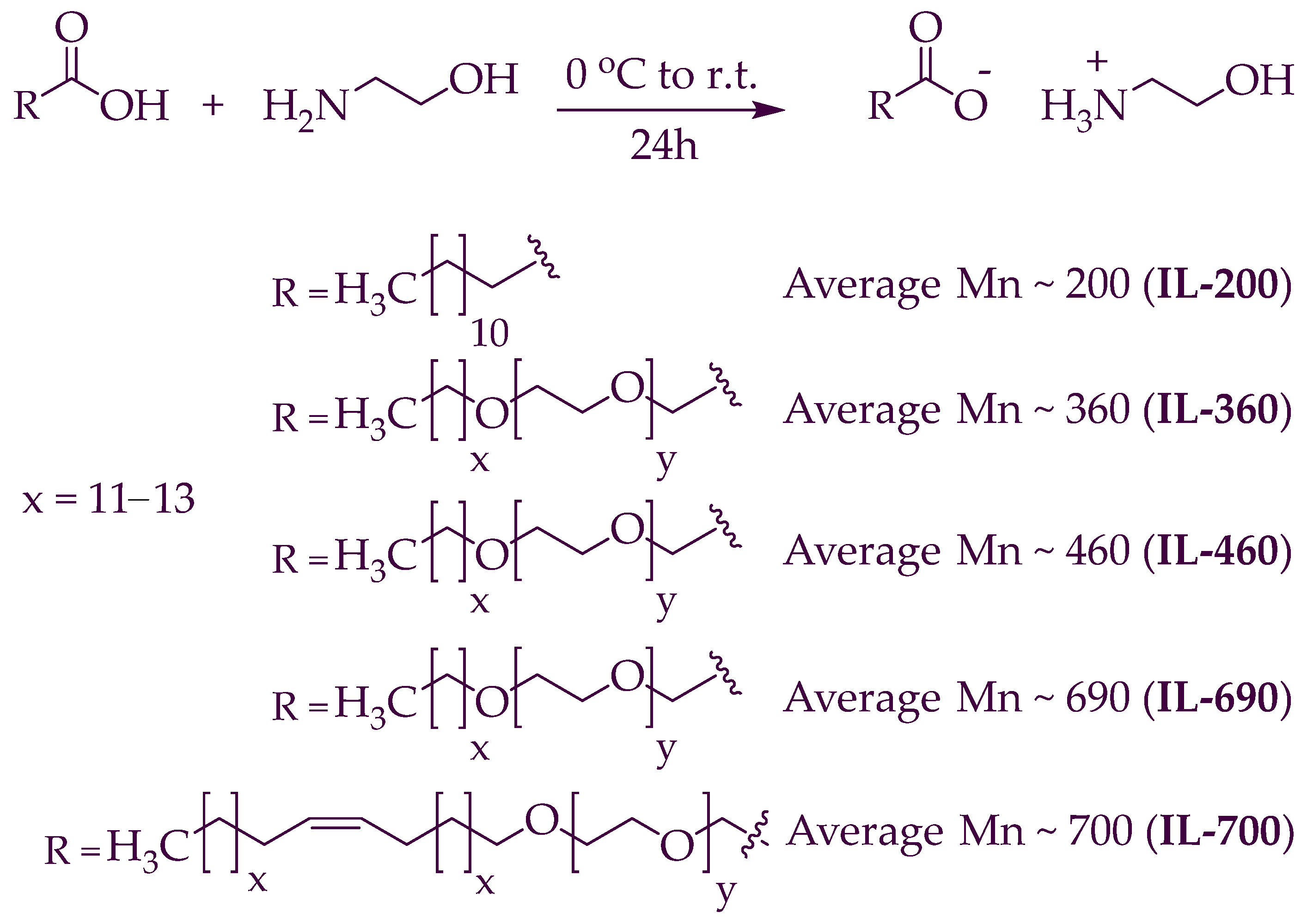
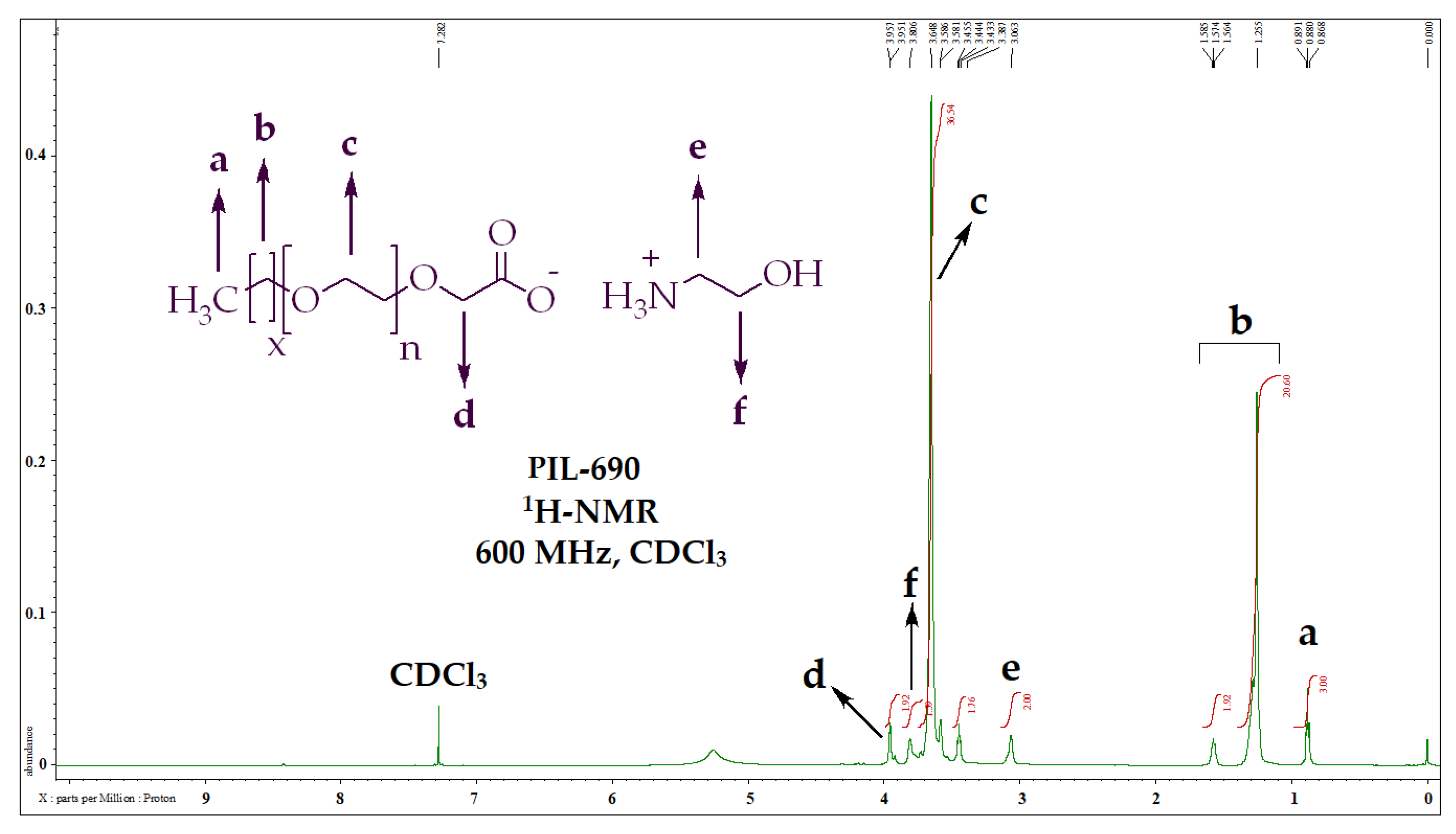

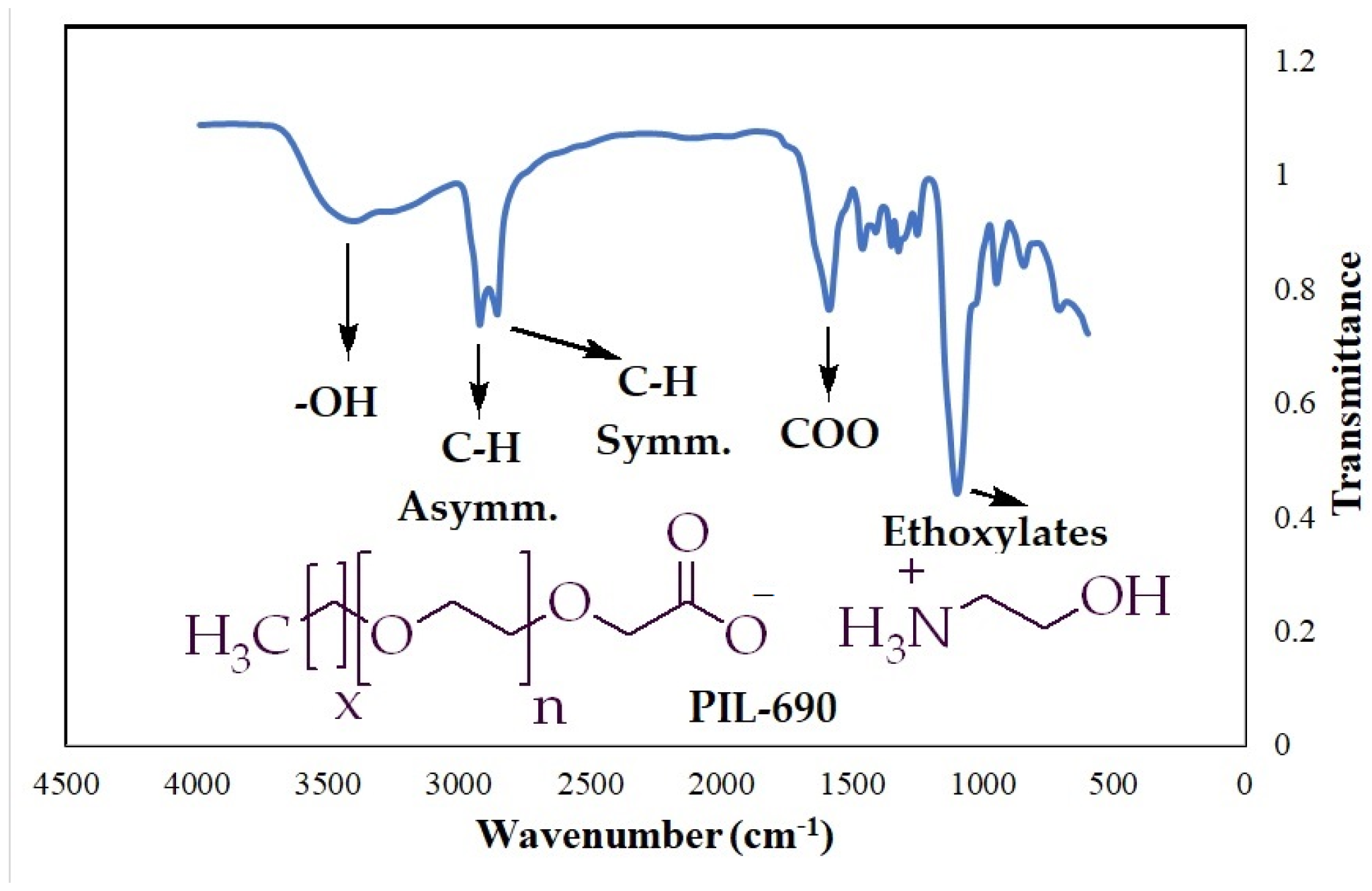
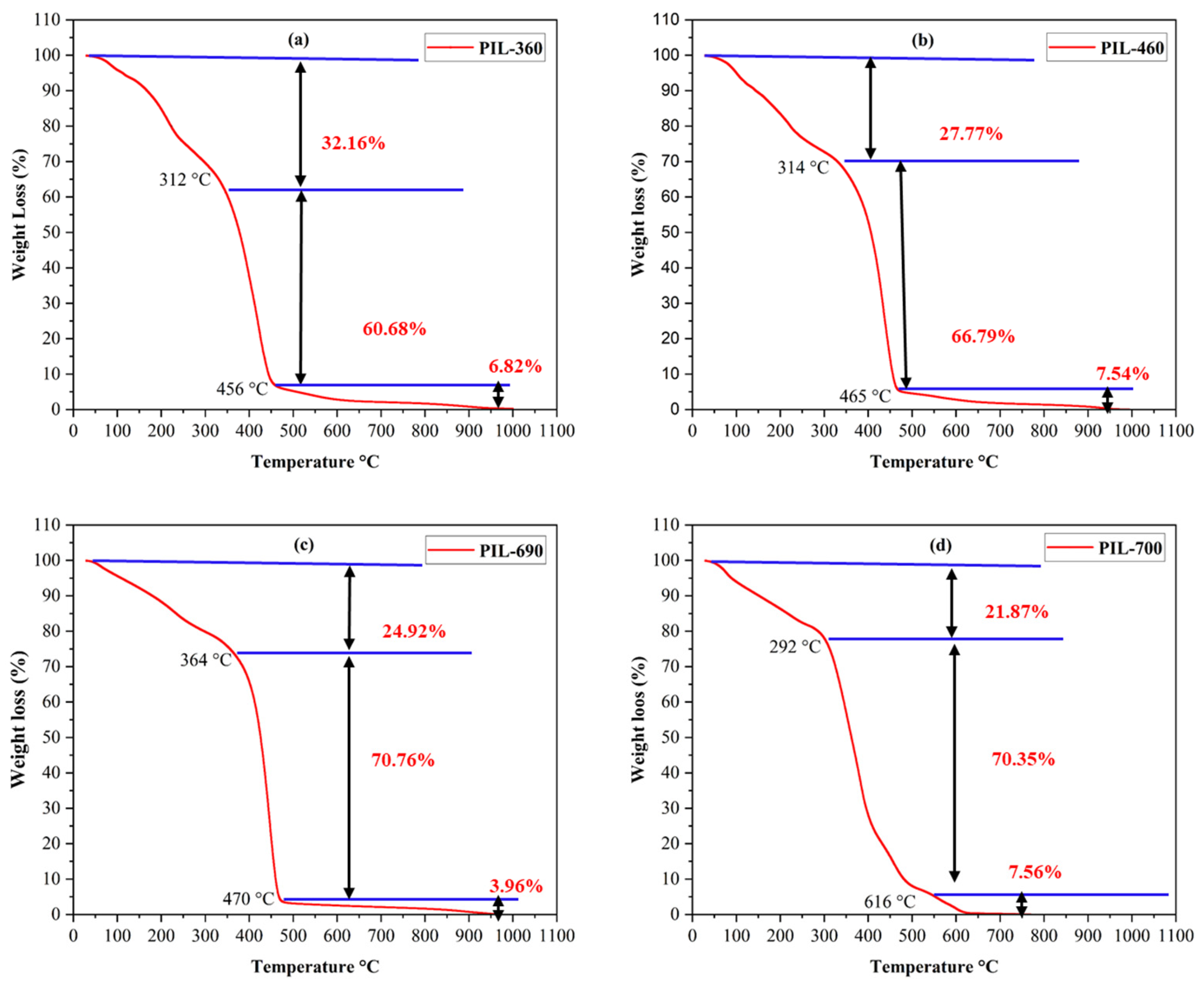
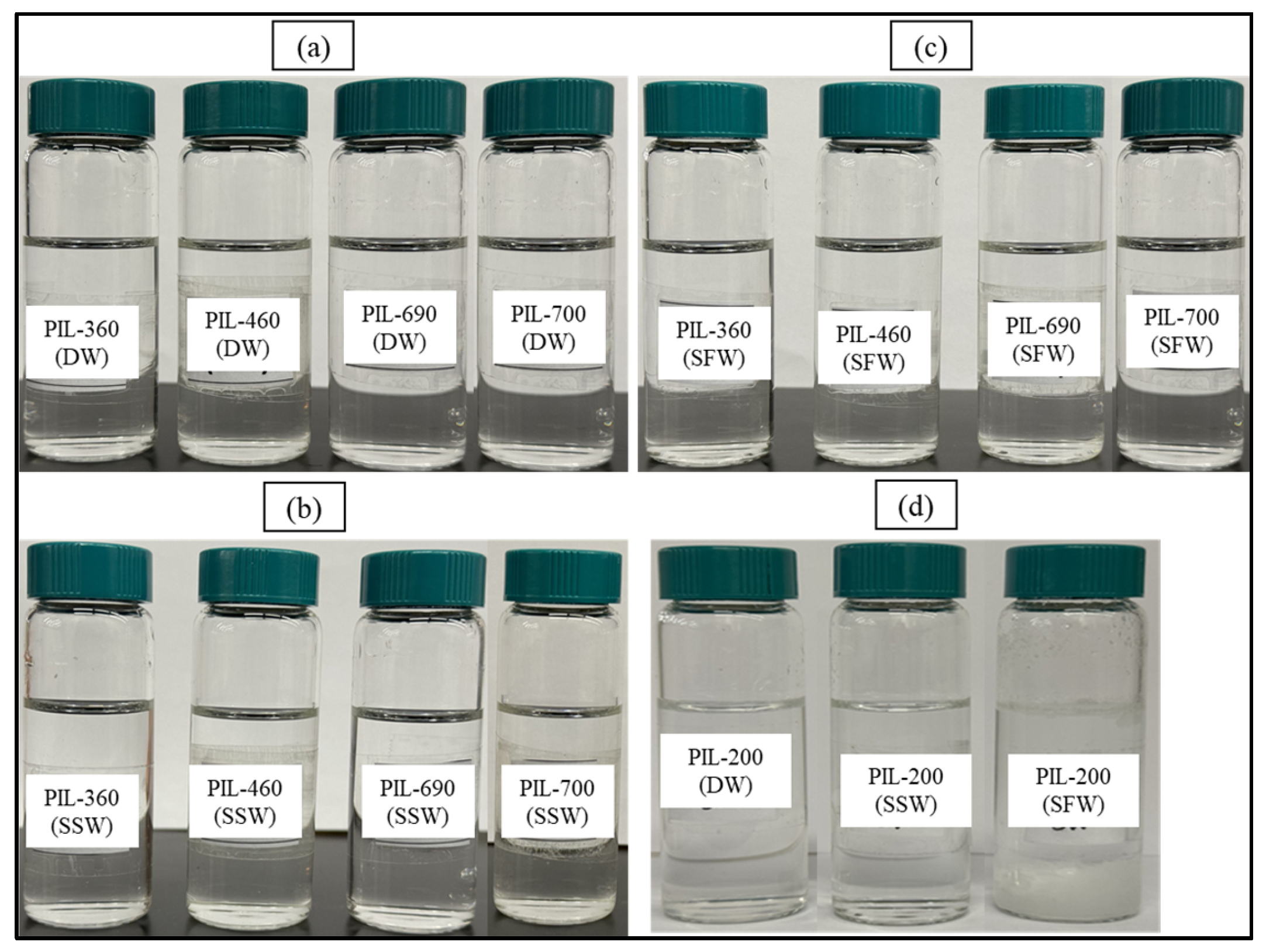

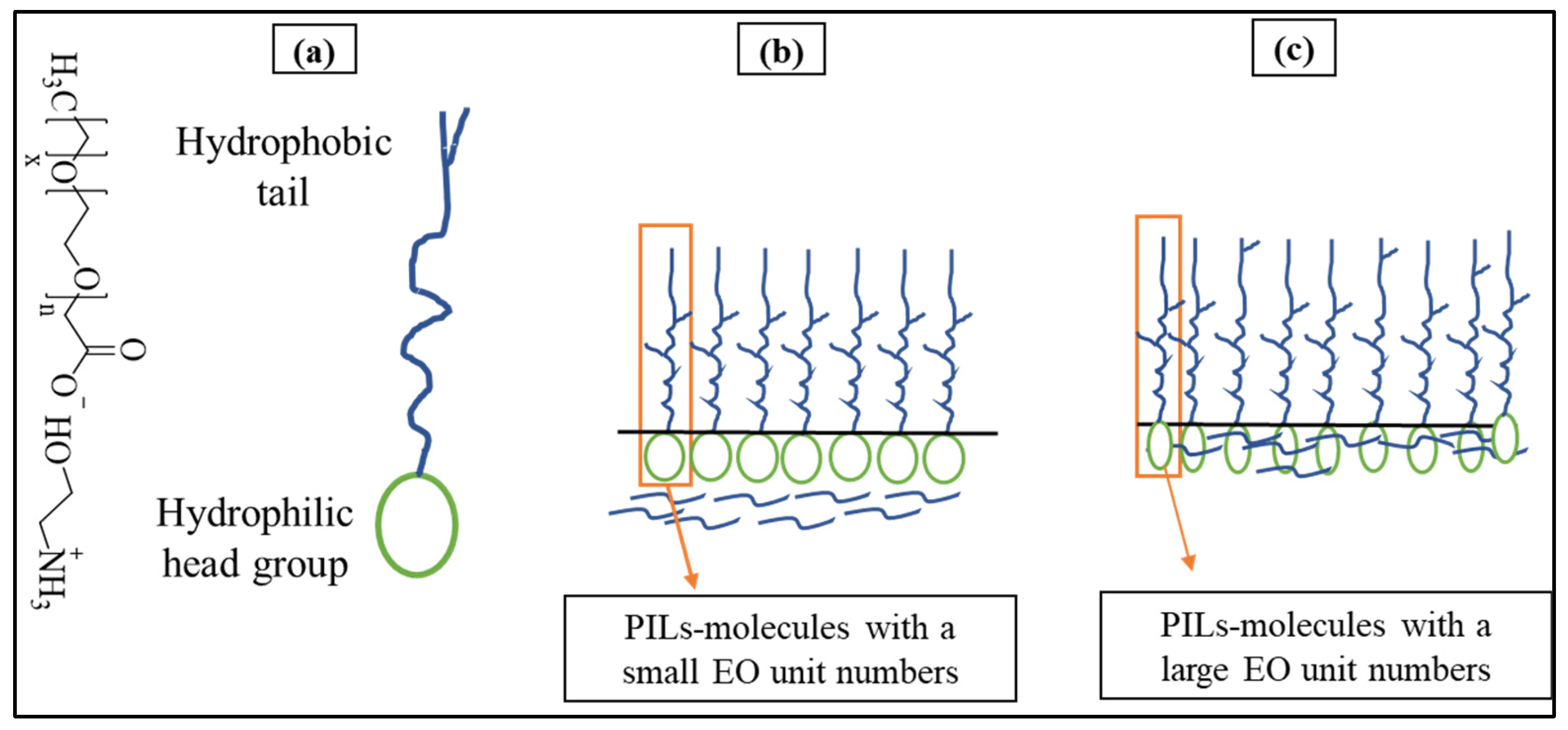
| Salt | Seawater (g/L) | Formation Water (g/L) |
|---|---|---|
| NaCl | 41.042 | 150.446 |
| CaCl2.2H2O | 2.385 | 69.841 |
| MgCl2.6H2O | 17.645 | 20.396 |
| Na2SO4 | 6.343 | 0.518 |
| NaHCO3 | 0.165 | 0.487 |
| Total TDS | 67.58 | 241.688 |
| 1H-NMR Data, δ in ppm, 600 MHz | |||||||
|---|---|---|---|---|---|---|---|
| Polymeric Ionic Liquids (PILs) | Glycolic Acid | Ethanolamine | |||||
| a | b | c | d | e | f | ||
| PIL-200 | 0.88 | 1.28 | 1.52 | - | - | 2.99 | 3.76 |
| PIL-360 | 0.88 | 1.25 | 1.57 | 3.65 | 4.15 | 3.02 | 3.92 |
| PIL-460 | 0.87 | 1.27 | 1.57 | 3.65 | 4.15 | 3.00 | 3.92 |
| PIL-690 | 0.88 | 1.26 | 1.57 | 3.65 | 3.96 | 3.06 | 3.96 |
| PIL-700 | 0.79 | 1.20 | 1.45 | 3.53 | 3.78 | 2.90 | 3.61 |
| Carbon NMR Data, δ in ppm, 150 MHz | |||||||||
|---|---|---|---|---|---|---|---|---|---|
| Polymeric Ionic Liquids (PILs) | Glycolic Acid | Ethanolamine | |||||||
| a | b | c | d | e | f | ||||
| PIL-200 | 14.1 | 22.7 | 26.3 | 29.7 | 31.9 | - | 181.7 | 41.9 | 58.8 |
| PIL-360 | 14.1 | 22.7 | 26.0 | 29.5 | 31.9 | 70.4 | 176.1 | 42.2 | 58.9 |
| PIL-460 | 14.1 | 22.6 | 26.0 | 29.4 | 31.8 | 70.2 | 176.1 | 42.4 | 59.4 |
| PIL-690 | 14.1 | 22.6 | 26.0 | 29.5 | 31.9 | 70.1 | 175.7 | 42.3 | 58.3 |
| PIL-700 | 13.2 | 22.4 | 26.8 | 29.4 | 31.7 | 70.3 | 176.5 | 41.7 | 58.0 |
| Polymeric Ionic Liquids (PILs) | FTIR Results | ||||
|---|---|---|---|---|---|
| υO-H | υasC-H | υsC-H | υCOO | υOCO (Symm.) | |
| PIL-200 | 3410 | 2920 | 2851 | 1531 | - |
| PIL-360 | 3360 | 2921 | 2853 | 1586 | 1107 |
| PIL-460 | 3406 | 2923 | 2854 | 1585 | 1099 |
| PIL-690 | 3421 | 2920 | 2855 | 1585 | 1099 |
| PIL-700 | 3410 | 2924 | 2854 | 1589 | 1099 |
| PILs | DW | SSW | SFW |
|---|---|---|---|
| PIL-200 | Cloudiness | Precipitation | Severe precipitation |
| PIL-360 | Transparent | Transparent | Transparent |
| PIL-460 | Transparent | Transparent | Transparent |
| PIL-690 | Transparent | Transparent | Transparent |
| PIL-700 | Transparent | Transparent | Transparent |
| Polymeric Ionic Liquids | cmc (mmol/L) | γcmc (mN/m) | Πcmc (mN/m) | Γmax (mol/mm2) | Amin (nm2) | ΔGmic (KJ/mol) | ΔGadv (KJ/mol) |
|---|---|---|---|---|---|---|---|
| PIL-360 | 0.031 | 22.009 | 49.991 | 4.582 × 10−12 | 0.362 | −10.985 | −17.555 |
| PIL-460 | 0.022 | 25.322 | 46.678 | 4.277 × 10−12 | 0.388 | −11.042 | −17.292 |
| PIL-690 | 0.018 | 33.013 | 38.987 | 3.471 × 10−12 | 0.394 | −11.790 | −18.554 |
| PIL-700 | 0.002 | 37.697 | 34.303 | 3.218 × 10−12 | 0.474 | −14.125 | −19.132 |
Disclaimer/Publisher’s Note: The statements, opinions and data contained in all publications are solely those of the individual author(s) and contributor(s) and not of MDPI and/or the editor(s). MDPI and/or the editor(s) disclaim responsibility for any injury to people or property resulting from any ideas, methods, instructions or products referred to in the content. |
© 2025 by the authors. Licensee MDPI, Basel, Switzerland. This article is an open access article distributed under the terms and conditions of the Creative Commons Attribution (CC BY) license (https://creativecommons.org/licenses/by/4.0/).
Share and Cite
Alotaibi, M.; Fahmi, M.; Nazar, M.; Mahboob, A.; Hussain, S.M.S.; Kamal, M.S. Effect of Degree of Ethoxylation on the Surface and Thermal Properties of Polymeric Ionic Liquids for Oilfield Applications. Polymers 2025, 17, 580. https://doi.org/10.3390/polym17050580
Alotaibi M, Fahmi M, Nazar M, Mahboob A, Hussain SMS, Kamal MS. Effect of Degree of Ethoxylation on the Surface and Thermal Properties of Polymeric Ionic Liquids for Oilfield Applications. Polymers. 2025; 17(5):580. https://doi.org/10.3390/polym17050580
Chicago/Turabian StyleAlotaibi, Mohammed, Mohanad Fahmi, Masooma Nazar, Ahmad Mahboob, Syed Muhammad Shakil Hussain, and Muhammad Shahzad Kamal. 2025. "Effect of Degree of Ethoxylation on the Surface and Thermal Properties of Polymeric Ionic Liquids for Oilfield Applications" Polymers 17, no. 5: 580. https://doi.org/10.3390/polym17050580
APA StyleAlotaibi, M., Fahmi, M., Nazar, M., Mahboob, A., Hussain, S. M. S., & Kamal, M. S. (2025). Effect of Degree of Ethoxylation on the Surface and Thermal Properties of Polymeric Ionic Liquids for Oilfield Applications. Polymers, 17(5), 580. https://doi.org/10.3390/polym17050580









